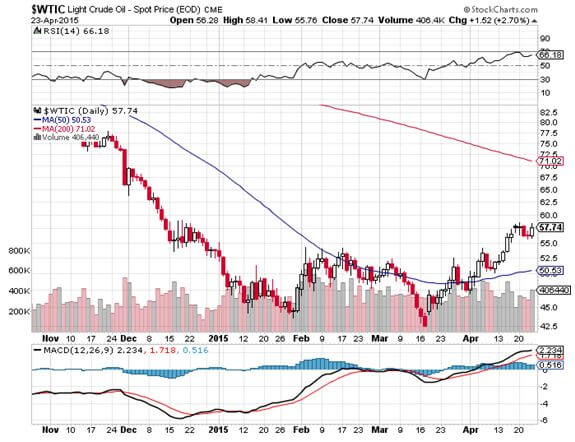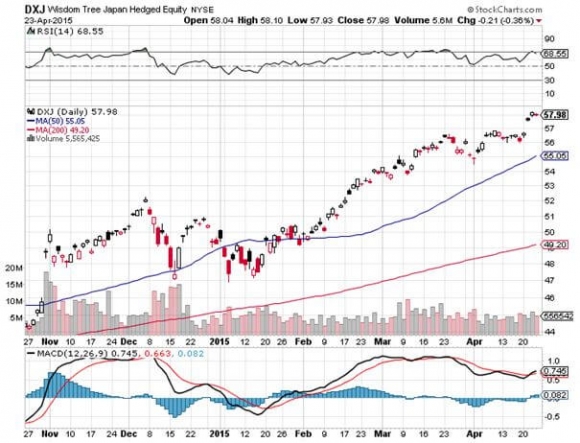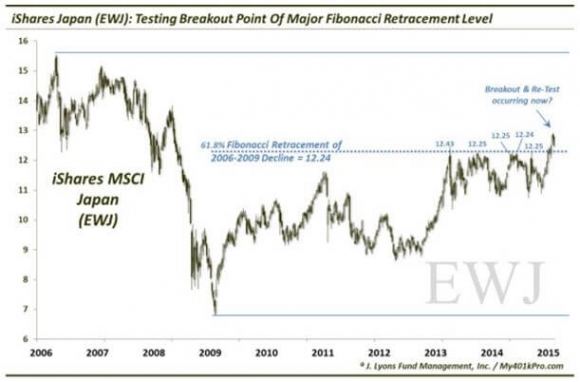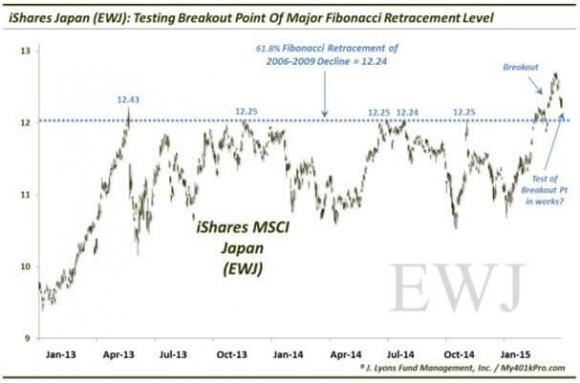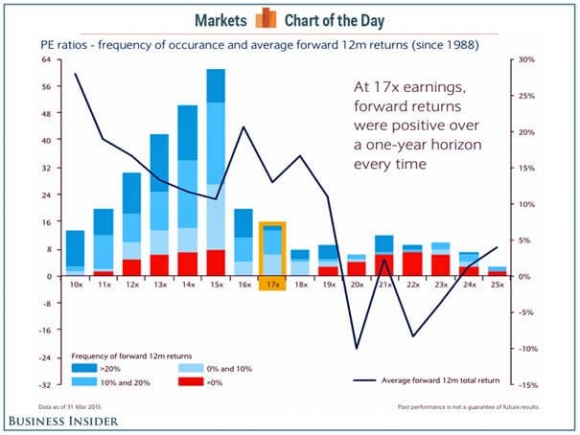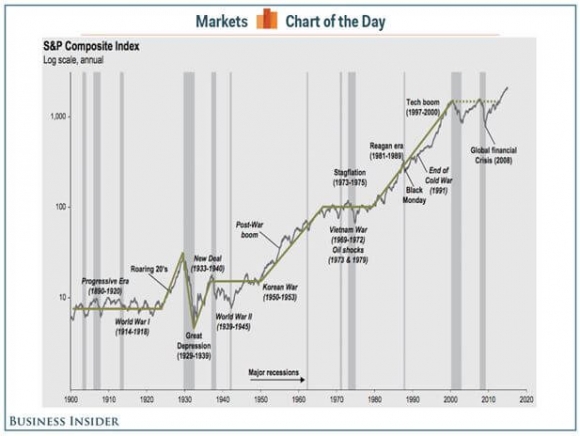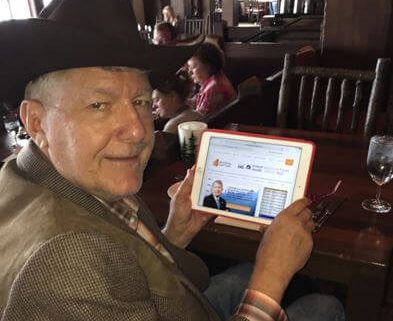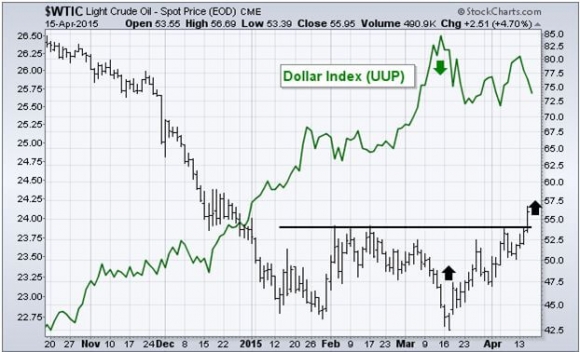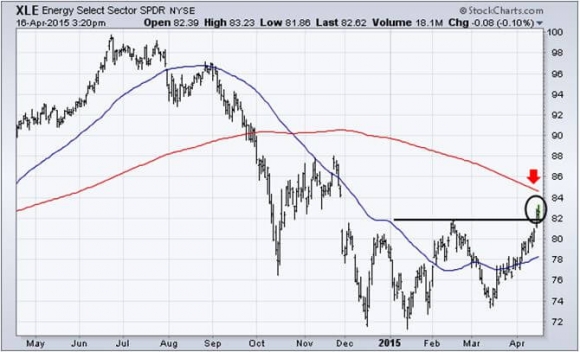Global Market Comments
April 24, 2015
Fiat Lux
Featured Trade:
(WEDNESDAY APRIL 29 GLOBAL STRATEGY WEBINAR),
(THE RECESSION IS OVER!),
(PLEASE USE MY FREE DATA BASE SEARCH)
The earnings announced for Q1 so far have been miserable, pummeled by a weak Euro, terrible weather and the West Coast port strike. But rather than collapse, global equity markets have punched through to new highs.
It isn?t just the United States that is performing this magic trick. Most European indexes (HEDJ) have blasted through to new eight-year highs.
Even more impressive is the Nikkei average?s breakout to a new 15-year summit, making short work of key long-term Fibonacci levels that have been holding the Japanese stock index back for months.
That totally works for me, as I am keeping 10% of my model-trading portfolio in the Wisdom Tree Japan Hedged Equity ETF (DXJ), and another 10% short the Currency Shares Japanese Yen Trust ETF (FXY).
What gives?
The hard truth is that the American economy suffered a recession during January to March, and that recession is now over. Call it the mini recession that came and went so fast that you missed it if you blinked.
What happens next is that the weather improves and the men on strike go back to work. If the Euro does continue to fall, it will only be the last 10% of a 45%, seven-year move from $1.60 to $0.88. It is rather late in the game to sell short the Euro. In other words, it is almost over.
So, there is nothing left for stocks to do but discount a new economic recovery. In layman?s terms, that means ?Go up.?
For economic historians, such as myself, this was a most peculiar recession. For a start, no one knew it was happening. By the time they did, it was over. Interest rates never moved an iota. Unemployment fell. And stocks maintained their relentless push northward.
Man, this is my kind of recession!
So, what happens next?
Stocks go up more, but not by much. We haven?t had a clearing, capitulation type sell off since October. Since we never went down by more than 4% this year, that means the gains from here will be modest as well. I?m thinking that the S&P 500 (SPY) might reach $215 by June.
That?s why I took the bold move of buying the S&P 500 SPDR?s (SPY) May, 2015 $215-$218 in-the-money vertical bear put spread yesterday. As long as the index trades below $215 on the May 15 expiration day, in 15 trading days, I will get to keep the maximum potential profit or some 12.6% on the trade in only 3 weeks.
Not bad.
If you don?t believe me, then take a look at the price of Texas tea. Since it bottomed on March 17, the price of crude has rocketed by an awesome 37%, from $42.50 to $58, one of the sharpest moves in history.
This set energy stocks, and my favorite, solar shares, on fire, which played a major role in supporting the indexes at their lofty levels. At this point, the entire world is hoping to buy energy on the next dip and turn their holdings into energy portfolios.
Let me toy with your mind a little bit more. With another economic recovery on hand, the Federal Reserve is going to have to raise interest rates sooner or later (Hey Janet! Call me!).
However, just as this bull market is unlike any other, so may be the next interest rate cycle. When the headline unemployment rate hits 5% next year, the Fed will boost rates, but only by ?%. After that, we may see a second, and possibly a third ?% hike.
Then they will be done. Interest rates will peak at 1% and then a new recession, possibly only another ?mini? one, will prompt a rapid decent in interest rates down to zero. In other words, the next entire interest rate cycle may have Fed funds go from 0.25% to 1%, and then down to 0%.
Pshaw! You may say. But consider this: Deflation is still everywhere. There is no hint of wage pressure whatsoever. Commodity prices have just staged a modest rally, but are still a fraction of their old highs.
And as long as Janet Yellen heads the Federal Reserve, which is another 4-9 years at the very least, there will be no interest rate increases until we have proof of real inflation. That leaves us with only the above-mentioned token interest rate rises for the foreseeable future.
Let me throw one more idea out there for you to chew over.
Take a look at the chart below from my friends at Business Insider. Every time stocks traded at a 17X multiple since 1988, shares generated a positive return over the following 12 months.
That certainly makes stocks look like a ?BUY? to me!
 Stocks at These Levels Requires No Magic Trick
Stocks at These Levels Requires No Magic Trick
Global Market Comments
April 23, 2015
Fiat Lux
SPECIAL BERSHIRE HATHAWAY ISSUE
Featured Trade:
(A CHAT WITH BERKSHIRE HATHAWAY?S WARREN BUFFET),
(BRK-A), (AXP), (WFC), (IBM), (KO), (GS), (AAPL), (UNP), (BAC)
Berkshire Hathaway Inc. (BRK-A)
American Express Company (AXP)
Wells Fargo & Company (WFC)
International Business Machines Corporation (IBM)
The Coca-Cola Company (KO)
The Goldman Sachs Group, Inc. (GS)
Apple Inc. (AAPL)
Union Pacific Corporation (UNP)
Bank of America Corporation (BAC)
Global Market Comments
April 22, 2015
Fiat Lux
Featured Trade:
(JUNE 29 LONDON STRATEGY LUNCHEON)
(THE TWO CENTURY DOLLAR SHORT),
(CNN?S JOHN LEWIS; THE DEATH OF A COLLEAGUE)
Global Market Comments
April 21, 2015
Fiat Lux
Featured Trade:
(JUNE 25 NEW YORK STRATEGY LUNCHEON)
(MY BRIEFING FROM THE JOINT CHIEFS OF STAFF),
(PANW), (PHO), (HACK), (FXI), (RSX),
(TESTIMONIAL)
Palo Alto Networks, Inc. (PANW)
PowerShares Water Resources ETF (PHO)
PureFunds ISE Cyber Security ETF (HACK)
iShares China Large-Cap (FXI)
Market Vectors Russia ETF (RSX)
Global Market Comments
April 20, 2015
Fiat Lux
Featured Trade:
(JUNE 22 WASHINGTON DC GLOBAL STRATEGY LUNCHEON)
(WHERE THE ECONOMIST BIG MAC INDEX FINDS CURRENCY VALUE),
(FXF), (FXE), (FXA), CYB)
(THE FALLING MARKET FOR KIDS),
(HOLLYWOOD CASHES IN ON WALL STREET TROUBLES)
CurrencyShares Swiss Franc ETF (FXF)
CurrencyShares Euro ETF (FXE)
CurrencyShares Australian Dollar ETF (FXA)
WisdomTree Chinese Yuan Strategy ETF (CYB)
Global Market Comments
April 17, 2015
Fiat Lux
Featured Trade:
(SPECIAL NOTE FOR MY APRIL 17 INCLINE VILLAGE GUESTS)
(LAS VEGAS WEDNESDAY MAY 8 GLOBAL STRAGEGY LUNCHEON)
(THE PORTFOLIO THAT WILL DOUBLE IN THREE YEARS)
Those who will be attending my Incline Village Global Strategy luncheon today, April 17 are welcome to join me on my daily hike afterwards.
You need to do something to work off the excellent lunch.
I?ll be kicking off from the trailhead at the Tunnel Creek Caf? off of Nevada State Highway 28.
Please bring your hiking boots, hat, sunscreen, and a canteen. The weather will be perfect tomorrow. I?ll bring the bear spray and the Bowie knife, as the mountain lions are migrating back up into the mountain this time of year.
Be sure to bring a coat and wool sweater. Coming down the mountain last night, it was a chilly 25 degrees.
We will start at Lake level at 6,125 feet and climb straight up to the Tahoe Rim Trail at 8,200 feet. Those inclined to do so can then continue on with me to a nearby peak at 9,500 feet.
I?ll even give you a handicap. You don?t have to carry my 60-pound pack. Nor do you have to pick up a 30 pound log at the summit and carry it back down to the parking lot for that extra bit if exercise.
Hey, it?s free energy!
Below, I have listed a portfolio of ten stocks that will almost certainly double in three years. If I am wrong, it will gain 100% in only two years.
But there is a catch. This basket of stocks may have to drop 20%-30% first. It is a cardinal rule of investment that if you want to earn higher returns, you must accept higher volatility as well.
It doesn?t require a rocket scientist to figure out that this is an energy-based portfolio.
Crude will almost certainly hit its trough in the current quarter, if it hasn?t already. But this python has a couple of pigs that it has to digest first.
As an old oilman, I can tell you that the oil majors have never been able to forecast the price of oil, and that is with all the resources in the world to accomplish this.
This is why they hedge out all their production in the futures market, or with long-term contracts with customers. The oil companies that thought they could predict the price of oil all went out of business a long time ago.
And as a mathematician, I can also tell you that this is an impossible task. There are just too many variables involved. So, don?t even try.
The bottom line is that absolutely no one can pinpoint when and where oil will hit bottom.
Let?s start with the supply side. Thanks to the avalanche of cash that poured into fracking plays at the top of the market last year, US oil production is still rising, some 500,000 barrels a day during the first half of 2015.
This is occurring because once money enters the production pipeline, it stays there forever. Drillers would rather complete a half finished well and sell its output at a loss for a couple of years, rather than shut down construction and lose everything.
However, new projects have fallen precipitously. You see this is the collapse of the number of drilling rigs in use, from a peak of 1,600 last year to only 700 last week.
Then there is the storage issue. Much of this new oil is going straight into storage. As a result, the facilities at Cushing, Oklahoma, will be full in a matter of weeks. Virtually every tanker in the world has already been chartered and is also loaded to the gunnels with Texas tea.
Once all the storage in the world is full to capacity, there is no alternative but to cap wells, or dump new production on the spot market. This could lead to the price Armageddon that so many investors have been worried about.
The peace deal with Iran won?t be a factor. For starters, an agreement is not a sure thing, with religious fundamentalists in both countries attempting to torpedo the deal.
Even if the negotiators are successful, it will take a year for Iran to ramp up its antiquated wells to get more product to market. And by the way, Iran is also thought to be storing oil it couldn?t sell in a fleet of tankers offshore.
Now, let?s look at the demand side. We only need two letters for this one: QE.
We are a mere 1? months into what is probably a 5-6 year program of quantitative easing in Europe. The Bank of Japan continues to dump massive amounts of cash into its own economy. Even China is easing.
In the meantime, the United States is still basking in the glow of its own just ended hyper aggressive $4 trillion QE strategy. It?s now looking like all of America?s 2015 economic growth will be concentrated in the final three quarters of the year.
This all adds up to a global synchronized economic recovery and much higher oil prices. Personally, I think oil could recover $70 a barrel in 2016, and $100 by 2018.
This is why large, long term institutional investors are happy to look across any potential $30 valley that may occur over the next few months and are loading the boat with energy stocks now.
Maybe you should do the same.
Global Market Comments
April 16, 2015
Fiat Lux
Featured Trade:
(FRIDAY, MAY 15 SAN FRANCISCO STRATEGY LUNCHEON)
(THE NEW COLD WAR)
(THE BEST FINANCIAL BOOK EVER)
Legal Disclaimer
There is a very high degree of risk involved in trading. Past results are not indicative of future returns. MadHedgeFundTrader.com and all individuals affiliated with this site assume no responsibilities for your trading and investment results. The indicators, strategies, columns, articles and all other features are for educational purposes only and should not be construed as investment advice. Information for futures trading observations are obtained from sources believed to be reliable, but we do not warrant its completeness or accuracy, or warrant any results from the use of the information. Your use of the trading observations is entirely at your own risk and it is your sole responsibility to evaluate the accuracy, completeness and usefulness of the information. You must assess the risk of any trade with your broker and make your own independent decisions regarding any securities mentioned herein. Affiliates of MadHedgeFundTrader.com may have a position or effect transactions in the securities described herein (or options thereon) and/or otherwise employ trading strategies that may be consistent or inconsistent with the provided strategies.


